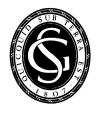

| Online: | |
| Visits: | |
| Stories: |

| Story Views | |
| Now: | |
| Last Hour: | |
| Last 24 Hours: | |
| Total: | |
The Lying Stones of Johann Beringer
Opening just in time for April Fools’ Day, the Geological Society Library’s latest exhibition ‘The Lying Stones of Johann Beringer’ tells the story of one of geology’s earliest recorded practical jokes.
Two of the Beringer stones belonging to William Buckland. Thanks to the Oxford University Museum of Natural History.
The unwitting dupe was the deeply pious, and rather pompous, Dr Johann Beringer (1667-1740) who was senior professor and Dean of the Faculty of Medicine at the University of Würzburg in Germany, and also Advisor and Chief Physician to the Prince-Bishop. Beringer was known to collect ‘fossils’, then a broad term covering various objects found in the earth such as minerals, ores and fossils in the modern sense. He was particularly interested in ‘lapides figurati’ (figured stones), that is stones that had naturally formed into recognisable images or shapes
Frontispiece to Beringer’s Lithographiae Wirceburgensis showing an idealised version of Mount Eivelstadt covered in the famous stones.
The prank involved the planting of manufactured figured stones in and around Mount Eivelstadt, Würzburg, Germany in 1725. The subject matter depicted included plant, insect and animal life, shooting stars, suns, moons and even Hebrew text which spelled out the name ‘Jehovah’. The naïve Beringer was completely taken in and expended much effort and expense acquiring around 2,000 of them over a period of six months. The joke could have been lost to posterity had he not published an academic treatise on them – Lithographiae Wirceburgensis in 1726.
“The figures expressed on these stones, especially those of insects, are so exactly fitted to the dimensions of the stones, that one would swear that they are the work of a very meticulous sculptor. For there is scarcely one in which the dimensions of the figure are not commonly commensurate to the length and breadth of the tablet.”
Extract from Chapter II of Lithographiae Wirceburgensis (1726).
The exhibition is a rare opportunity to see together nineteen examples of Beringer’s ‘Lügensteine’ (lying stones) which have been kindly lent by the Oxford University Museum of Natural History and the Natural History Museum, London.
‘The Lying Stones of Johann Beringer’, runs from 30 March-14 June 2017.
In conjunction with the exhibition, the Library is hosting a talk “Fossil fraud on a massive scale: the ‘lying stones’ of Johann Beringer” by Paul Taylor from the Natural History Museum, at 6pm on 6 April 2017.
Completing the evening will be another talk on history’s most famous geological fraudster “Piltdown Man and Charles Dawson’s career in forgery”, by David Bate from the British Geological Survey, at 7.30pm.
Attendees can view the current exhibition and also see the Society’s famous painting ‘Discussion on the Piltdown Skull’.
Tickets cost £6 per talk. To book see: www.geolsoc.org.uk/Library-and-Information-Services/Library-Events/F-is-for-Fake or email [email protected]
![]()
Source: http://blog.geolsoc.org.uk/2017/04/01/the-lying-stones-of-johann-beringer/


